CHRYSLER PACIFICA 2007 1.G Owners Manual
Manufacturer: CHRYSLER, Model Year: 2007, Model line: PACIFICA, Model: CHRYSLER PACIFICA 2007 1.GPages: 464, PDF Size: 5.92 MB
Page 311 of 464
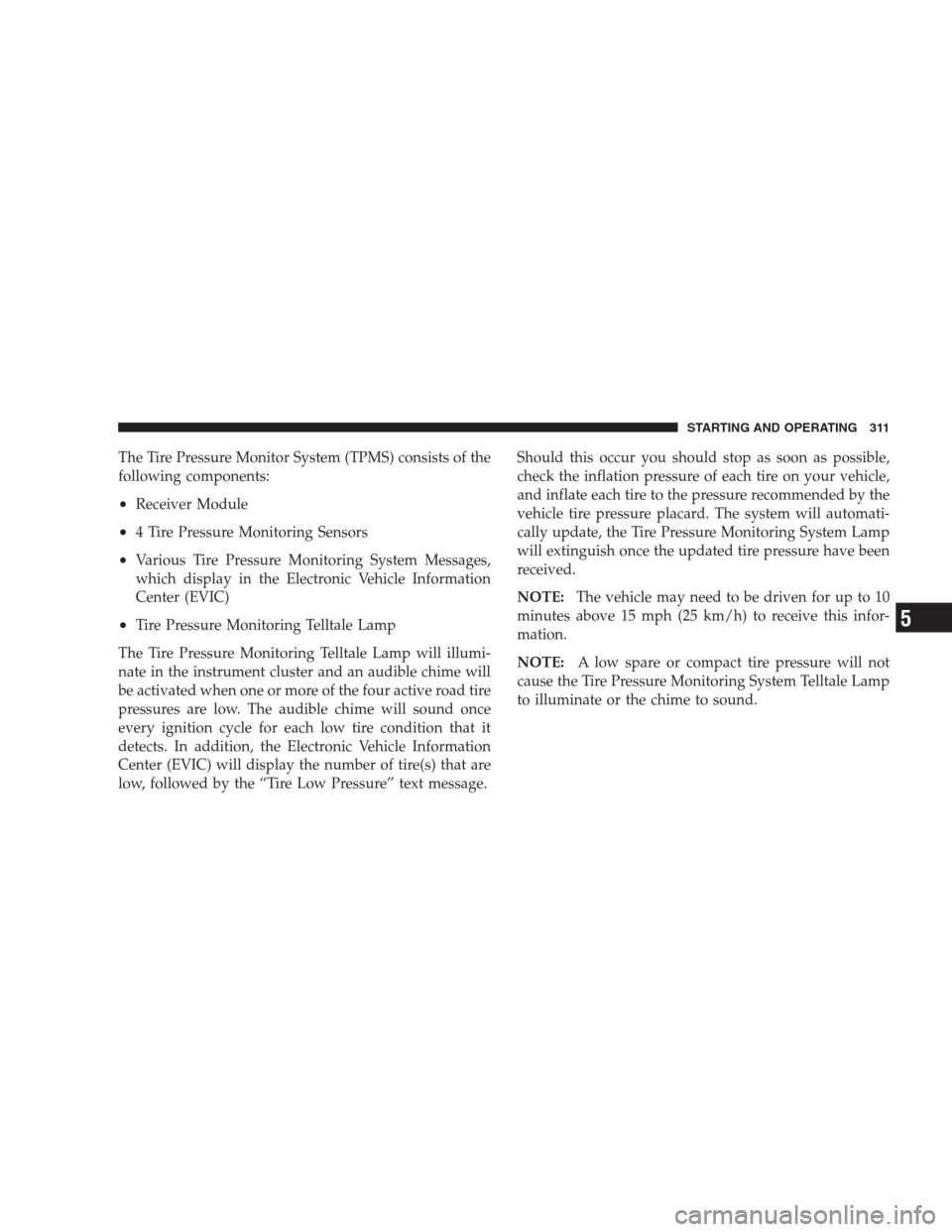
The Tire Pressure Monitor System (TPMS) consists of the
following components:
•Receiver Module
•4 Tire Pressure Monitoring Sensors
•Various Tire Pressure Monitoring System Messages,
which display in the Electronic Vehicle Information
Center (EVIC)
•Tire Pressure Monitoring Telltale Lamp
The Tire Pressure Monitoring Telltale Lamp will illumi-
nate in the instrument cluster and an audible chime will
be activated when one or more of the four active road tire
pressures are low. The audible chime will sound once
every ignition cycle for each low tire condition that it
detects. In addition, the Electronic Vehicle Information
Center (EVIC) will display the number of tire(s) that are
low, followed by the “Tire Low Pressure” text message.Should this occur you should stop as soon as possible,
check the inflation pressure of each tire on your vehicle,
and inflate each tire to the pressure recommended by the
vehicle tire pressure placard. The system will automati-
cally update, the Tire Pressure Monitoring System Lamp
will extinguish once the updated tire pressure have been
received.
NOTE:The vehicle may need to be driven for up to 10
minutes above 15 mph (25 km/h) to receive this infor-
mation.
NOTE:A low spare or compact tire pressure will not
cause the Tire Pressure Monitoring System Telltale Lamp
to illuminate or the chime to sound.
STARTING AND OPERATING 311
5
Page 312 of 464
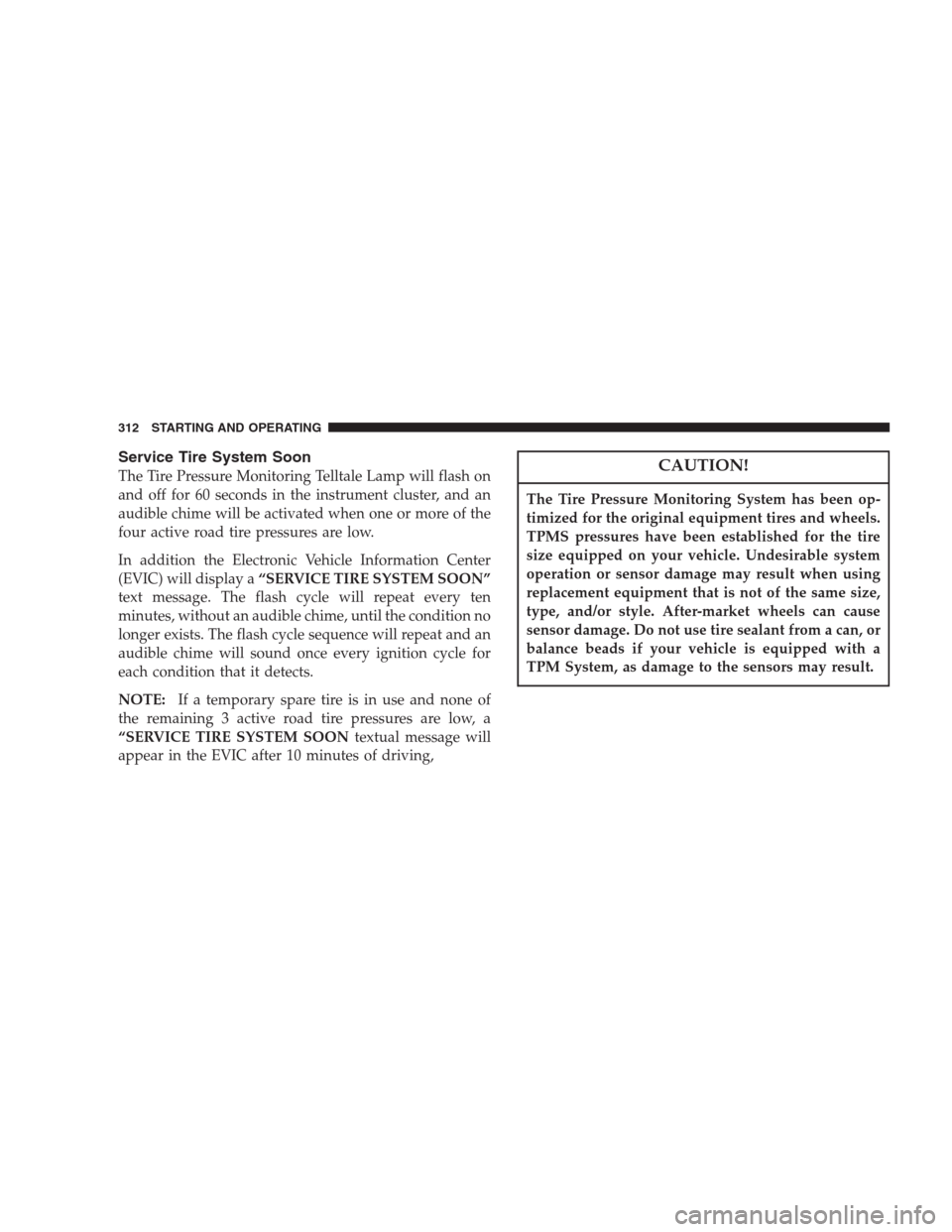
Service Tire System Soon
The Tire Pressure Monitoring Telltale Lamp will flash on
and off for 60 seconds in the instrument cluster, and an
audible chime will be activated when one or more of the
four active road tire pressures are low.
In addition the Electronic Vehicle Information Center
(EVIC) will display a“SERVICE TIRE SYSTEM SOON”
text message. The flash cycle will repeat every ten
minutes, without an audible chime, until the condition no
longer exists. The flash cycle sequence will repeat and an
audible chime will sound once every ignition cycle for
each condition that it detects.
NOTE:If a temporary spare tire is in use and none of
the remaining 3 active road tire pressures are low, a
“SERVICE TIRE SYSTEM SOONtextual message will
appear in the EVIC after 10 minutes of driving,CAUTION!
The Tire Pressure Monitoring System has been op-
timized for the original equipment tires and wheels.
TPMS pressures have been established for the tire
size equipped on your vehicle. Undesirable system
operation or sensor damage may result when using
replacement equipment that is not of the same size,
type, and/or style. After-market wheels can cause
sensor damage. Do not use tire sealant from a can, or
balance beads if your vehicle is equipped with a
TPM System, as damage to the sensors may result.
312 STARTING AND OPERATING
Page 313 of 464
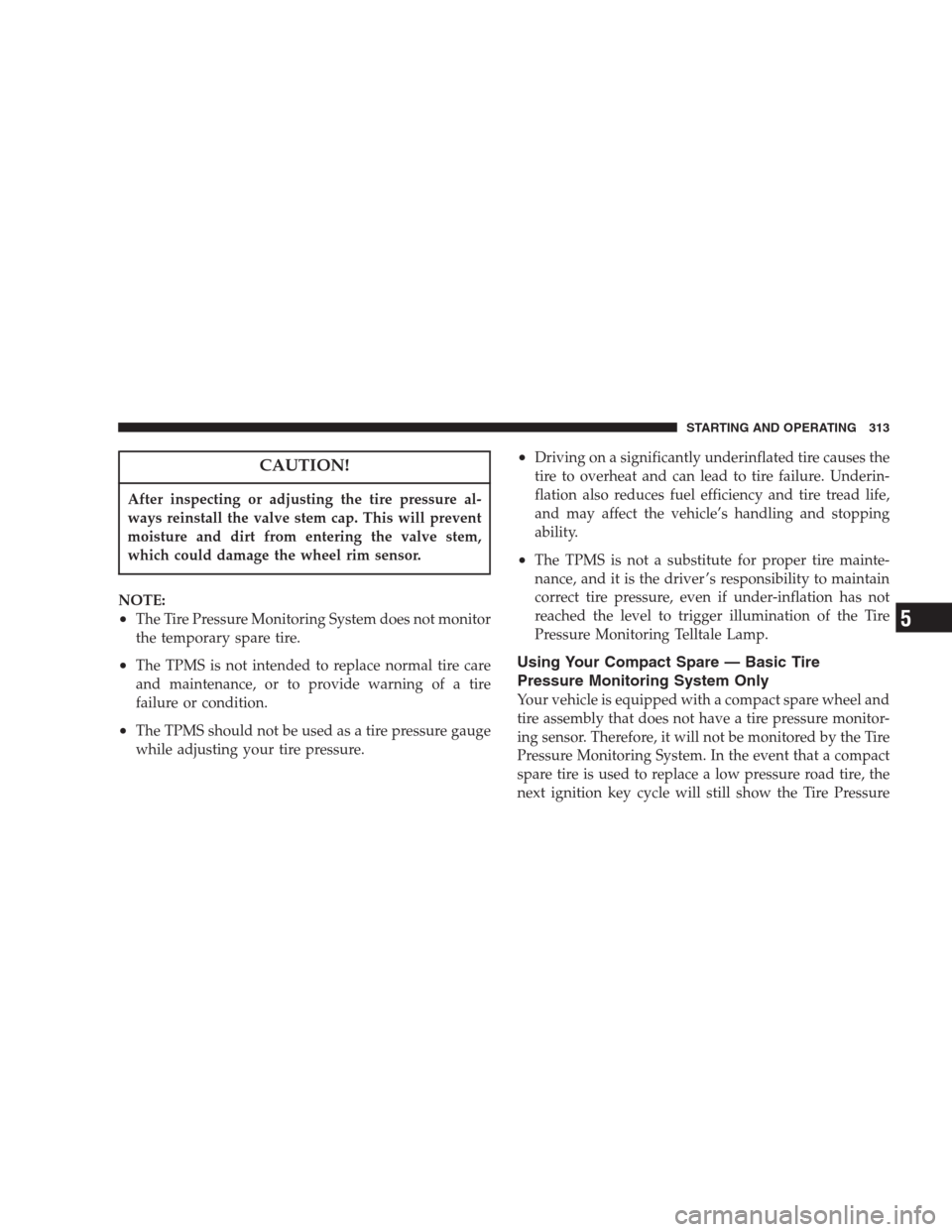
CAUTION!
After inspecting or adjusting the tire pressure al-
ways reinstall the valve stem cap. This will prevent
moisture and dirt from entering the valve stem,
which could damage the wheel rim sensor.
NOTE:
•The Tire Pressure Monitoring System does not monitor
the temporary spare tire.
•The TPMS is not intended to replace normal tire care
and maintenance, or to provide warning of a tire
failure or condition.
•The TPMS should not be used as a tire pressure gauge
while adjusting your tire pressure.
•Driving on a significantly underinflated tire causes the
tire to overheat and can lead to tire failure. Underin-
flation also reduces fuel efficiency and tire tread life,
and may affect the vehicle’s handling and stopping
ability.
•The TPMS is not a substitute for proper tire mainte-
nance, and it is the driver ’s responsibility to maintain
correct tire pressure, even if under-inflation has not
reached the level to trigger illumination of the Tire
Pressure Monitoring Telltale Lamp.
Using Your Compact Spare — Basic Tire
Pressure Monitoring System Only
Your vehicle is equipped with a compact spare wheel and
tire assembly that does not have a tire pressure monitor-
ing sensor. Therefore, it will not be monitored by the Tire
Pressure Monitoring System. In the event that a compact
spare tire is used to replace a low pressure road tire, the
next ignition key cycle will still show the Tire Pressure
STARTING AND OPERATING 313
5
Page 314 of 464
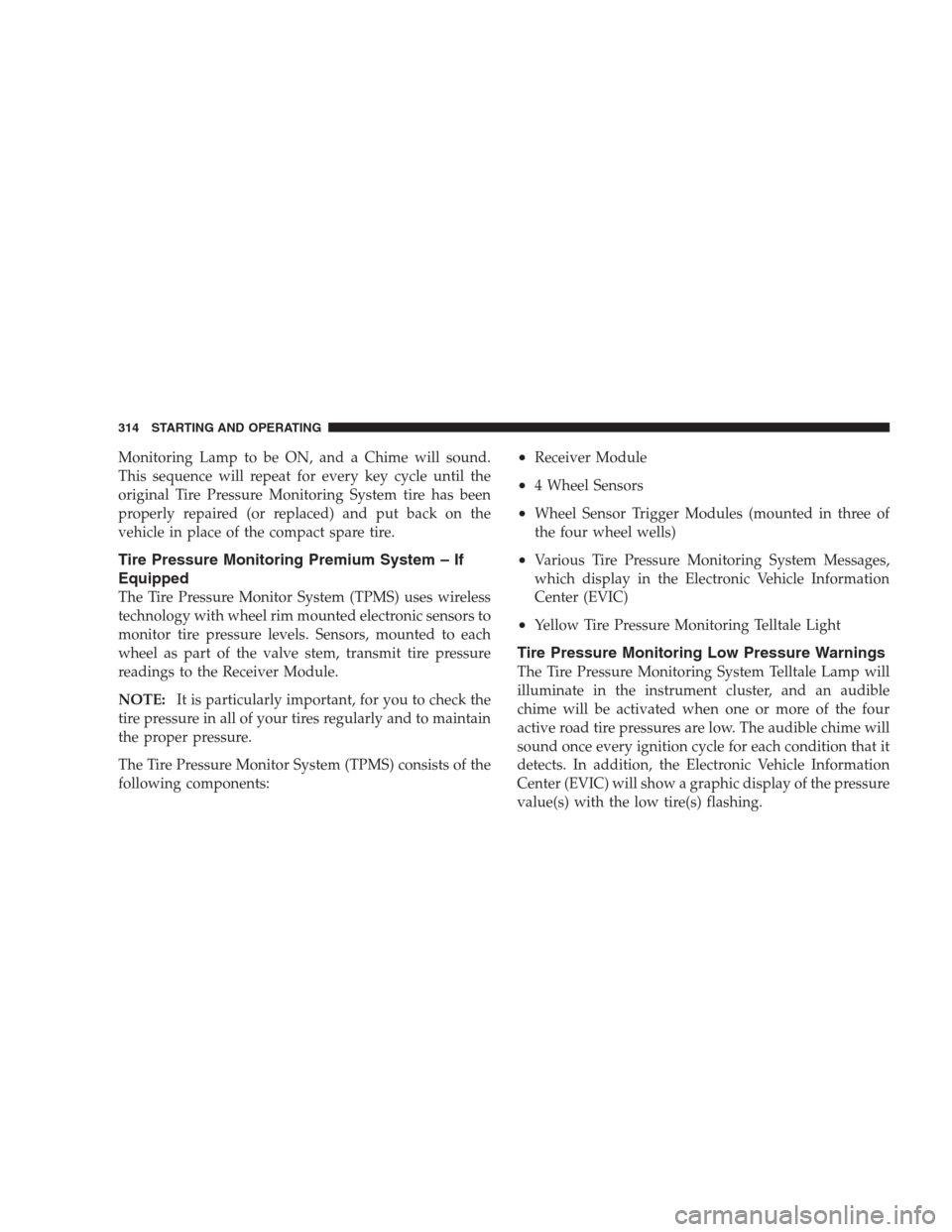
Monitoring Lamp to be ON, and a Chime will sound.
This sequence will repeat for every key cycle until the
original Tire Pressure Monitoring System tire has been
properly repaired (or replaced) and put back on the
vehicle in place of the compact spare tire.
Tire Pressure Monitoring Premium System – If
Equipped
The Tire Pressure Monitor System (TPMS) uses wireless
technology with wheel rim mounted electronic sensors to
monitor tire pressure levels. Sensors, mounted to each
wheel as part of the valve stem, transmit tire pressure
readings to the Receiver Module.
NOTE:It is particularly important, for you to check the
tire pressure in all of your tires regularly and to maintain
the proper pressure.
The Tire Pressure Monitor System (TPMS) consists of the
following components:
•Receiver Module
•4 Wheel Sensors
•Wheel Sensor Trigger Modules (mounted in three of
the four wheel wells)
•Various Tire Pressure Monitoring System Messages,
which display in the Electronic Vehicle Information
Center (EVIC)
•Yellow Tire Pressure Monitoring Telltale Light
Tire Pressure Monitoring Low Pressure Warnings
The Tire Pressure Monitoring System Telltale Lamp will
illuminate in the instrument cluster, and an audible
chime will be activated when one or more of the four
active road tire pressures are low. The audible chime will
sound once every ignition cycle for each condition that it
detects. In addition, the Electronic Vehicle Information
Center (EVIC) will show a graphic display of the pressure
value(s) with the low tire(s) flashing.
314 STARTING AND OPERATING
Page 315 of 464
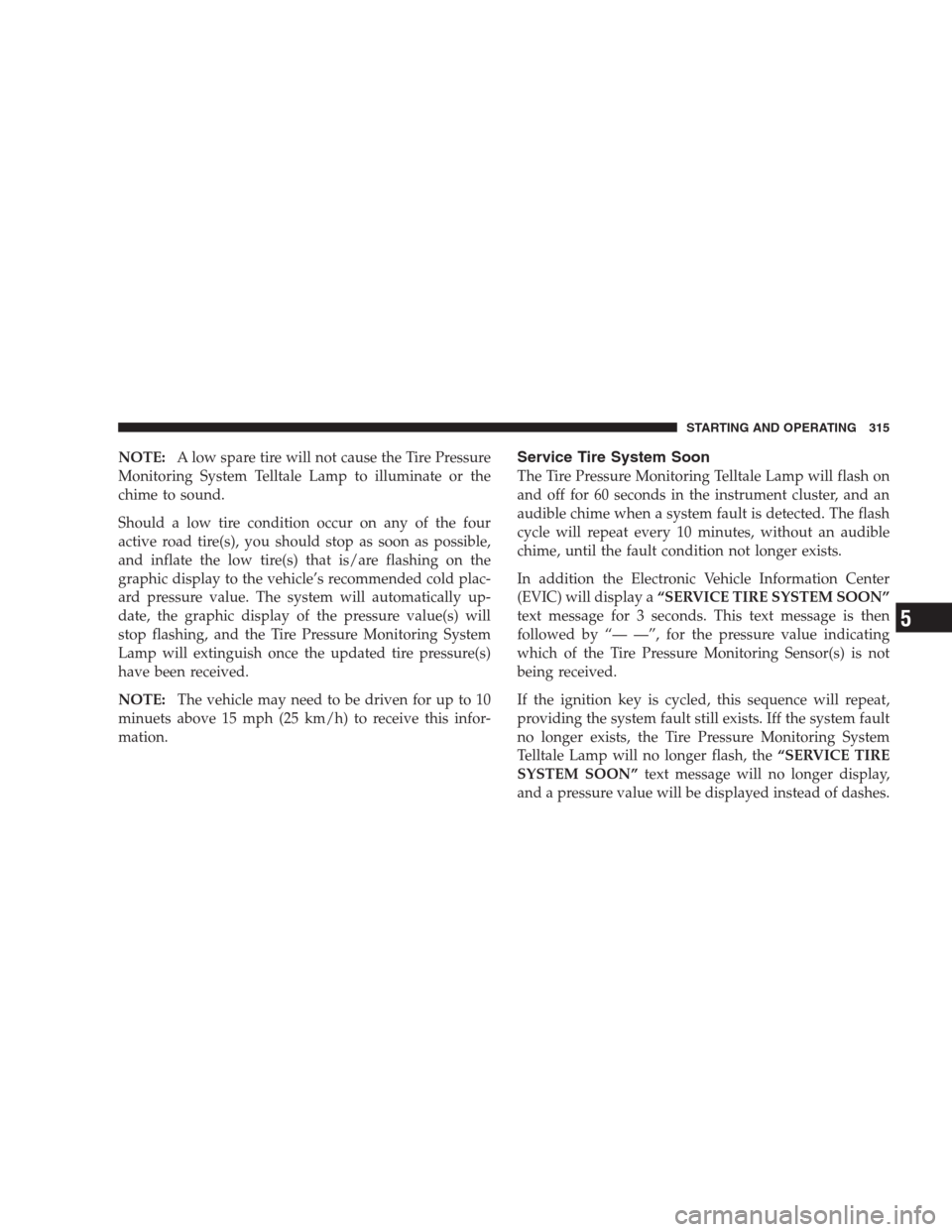
NOTE:A low spare tire will not cause the Tire Pressure
Monitoring System Telltale Lamp to illuminate or the
chime to sound.
Should a low tire condition occur on any of the four
active road tire(s), you should stop as soon as possible,
and inflate the low tire(s) that is/are flashing on the
graphic display to the vehicle’s recommended cold plac-
ard pressure value. The system will automatically up-
date, the graphic display of the pressure value(s) will
stop flashing, and the Tire Pressure Monitoring System
Lamp will extinguish once the updated tire pressure(s)
have been received.
NOTE:The vehicle may need to be driven for up to 10
minuets above 15 mph (25 km/h) to receive this infor-
mation.Service Tire System Soon
The Tire Pressure Monitoring Telltale Lamp will flash on
and off for 60 seconds in the instrument cluster, and an
audible chime when a system fault is detected. The flash
cycle will repeat every 10 minutes, without an audible
chime, until the fault condition not longer exists.
In addition the Electronic Vehicle Information Center
(EVIC) will display a“SERVICE TIRE SYSTEM SOON”
text message for 3 seconds. This text message is then
followed by “— —”, for the pressure value indicating
which of the Tire Pressure Monitoring Sensor(s) is not
being received.
If the ignition key is cycled, this sequence will repeat,
providing the system fault still exists. Iff the system fault
no longer exists, the Tire Pressure Monitoring System
Telltale Lamp will no longer flash, the“SERVICE TIRE
SYSTEM SOON”text message will no longer display,
and a pressure value will be displayed instead of dashes.
STARTING AND OPERATING 315
5
Page 316 of 464
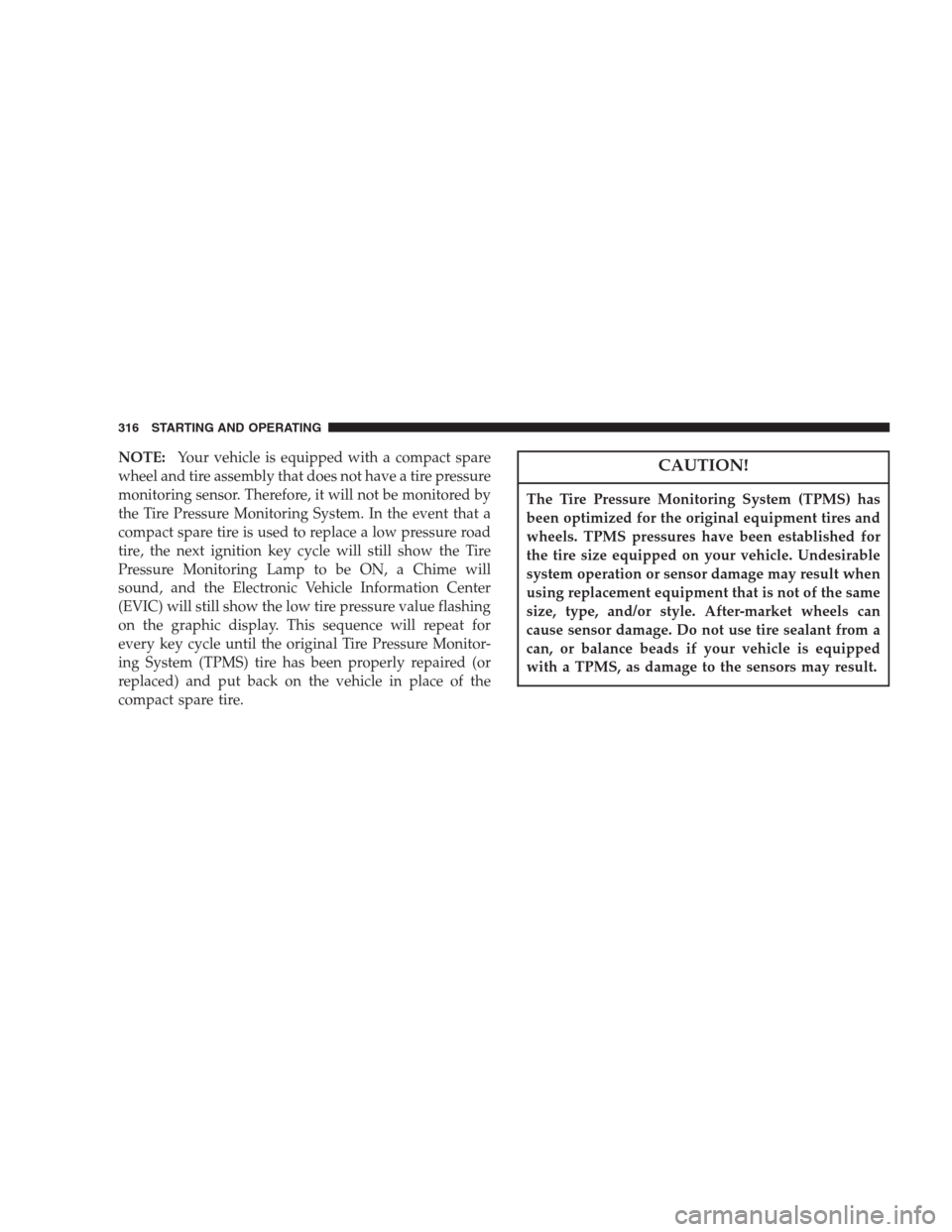
NOTE:Your vehicle is equipped with a compact spare
wheel and tire assembly that does not have a tire pressure
monitoring sensor. Therefore, it will not be monitored by
the Tire Pressure Monitoring System. In the event that a
compact spare tire is used to replace a low pressure road
tire, the next ignition key cycle will still show the Tire
Pressure Monitoring Lamp to be ON, a Chime will
sound, and the Electronic Vehicle Information Center
(EVIC) will still show the low tire pressure value flashing
on the graphic display. This sequence will repeat for
every key cycle until the original Tire Pressure Monitor-
ing System (TPMS) tire has been properly repaired (or
replaced) and put back on the vehicle in place of the
compact spare tire.CAUTION!
The Tire Pressure Monitoring System (TPMS) has
been optimized for the original equipment tires and
wheels. TPMS pressures have been established for
the tire size equipped on your vehicle. Undesirable
system operation or sensor damage may result when
using replacement equipment that is not of the same
size, type, and/or style. After-market wheels can
cause sensor damage. Do not use tire sealant from a
can, or balance beads if your vehicle is equipped
with a TPMS, as damage to the sensors may result.
316 STARTING AND OPERATING
Page 317 of 464
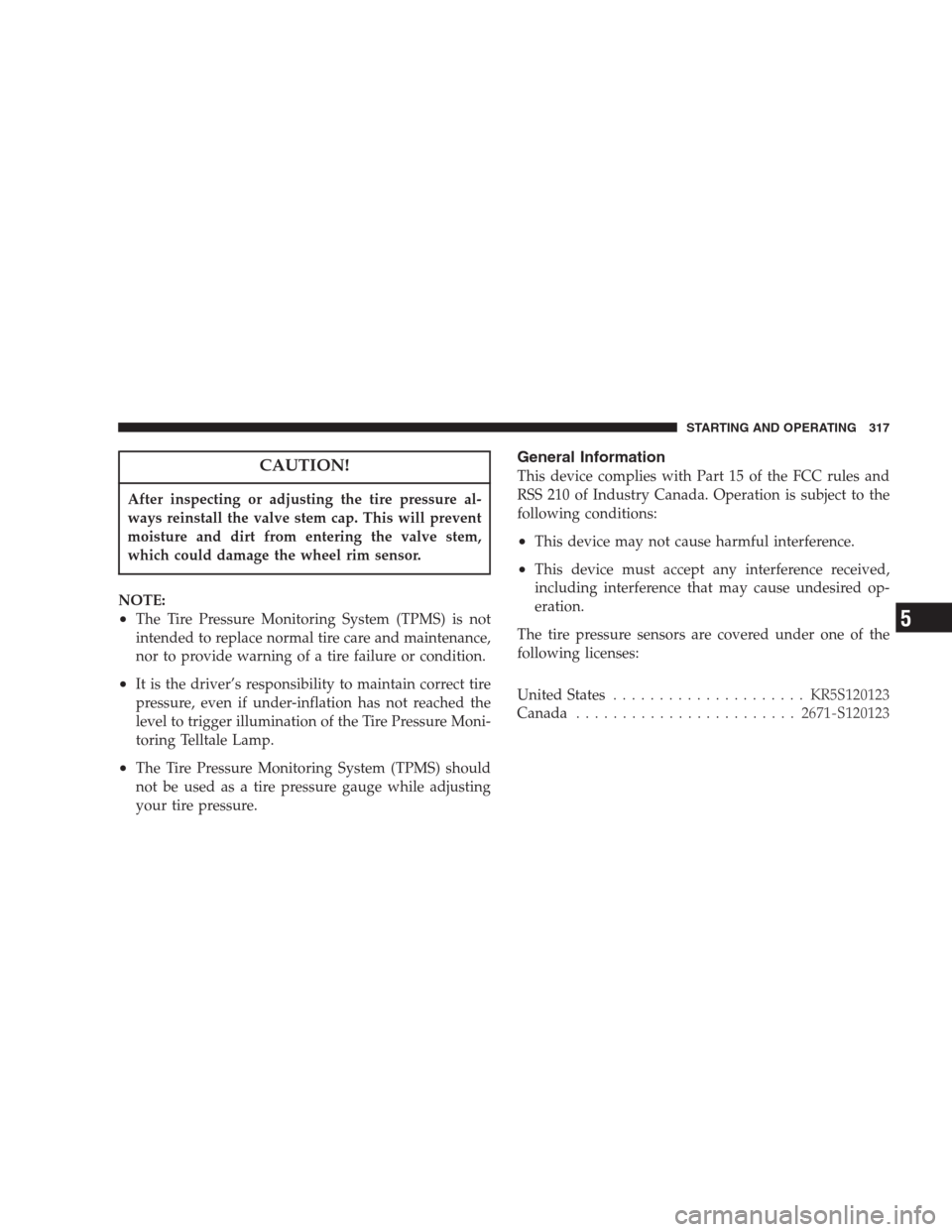
CAUTION!
After inspecting or adjusting the tire pressure al-
ways reinstall the valve stem cap. This will prevent
moisture and dirt from entering the valve stem,
which could damage the wheel rim sensor.
NOTE:
•The Tire Pressure Monitoring System (TPMS) is not
intended to replace normal tire care and maintenance,
nor to provide warning of a tire failure or condition.
•It is the driver’s responsibility to maintain correct tire
pressure, even if under-inflation has not reached the
level to trigger illumination of the Tire Pressure Moni-
toring Telltale Lamp.
•The Tire Pressure Monitoring System (TPMS) should
not be used as a tire pressure gauge while adjusting
your tire pressure.
General Information
This device complies with Part 15 of the FCC rules and
RSS 210 of Industry Canada. Operation is subject to the
following conditions:
•This device may not cause harmful interference.
•This device must accept any interference received,
including interference that may cause undesired op-
eration.
The tire pressure sensors are covered under one of the
following licenses:
United States.....................KR5S120123
Canada........................2671-S120123
STARTING AND OPERATING 317
5
Page 318 of 464
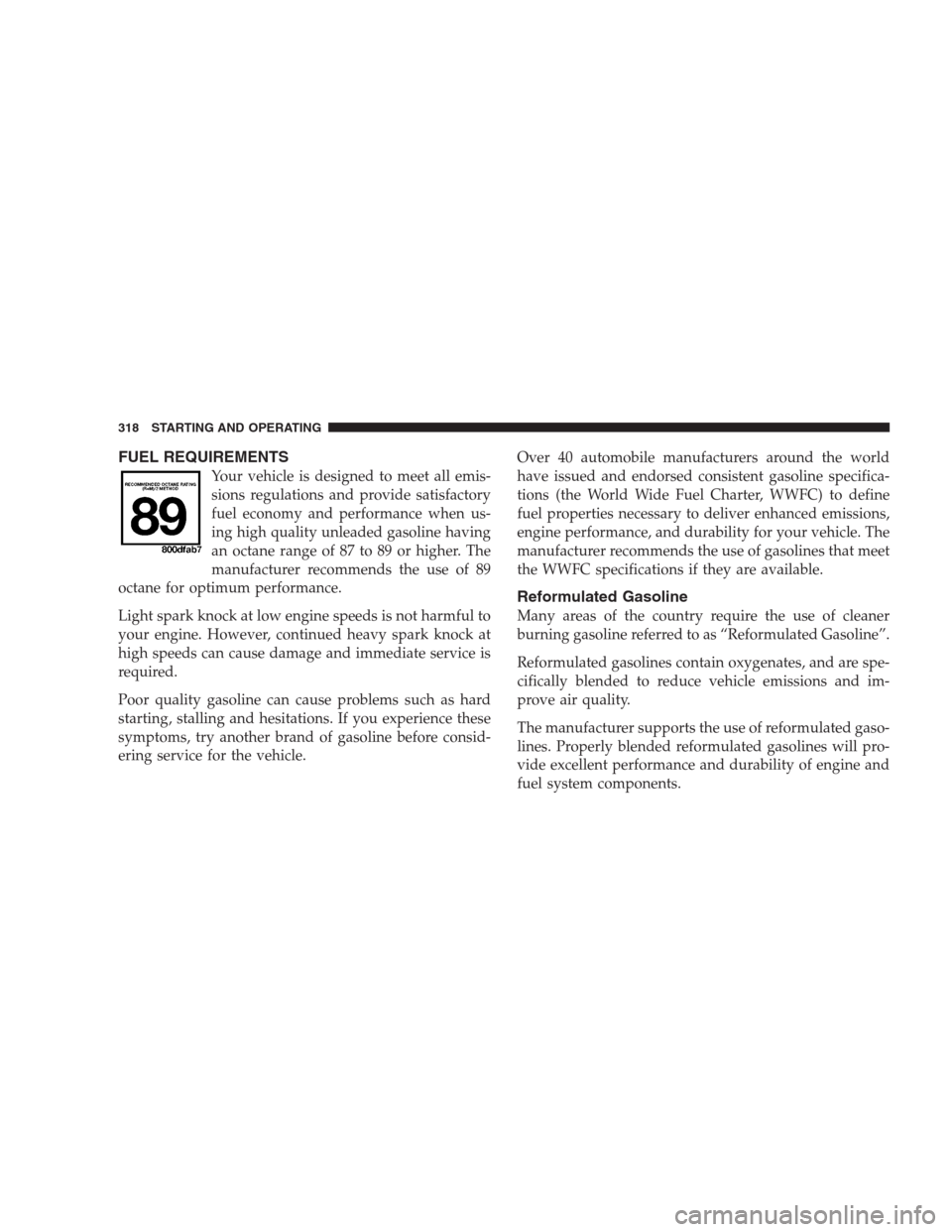
FUEL REQUIREMENTS
Your vehicle is designed to meet all emis-
sions regulations and provide satisfactory
fuel economy and performance when us-
ing high quality unleaded gasoline having
an octane range of 87 to 89 or higher. The
manufacturer recommends the use of 89
octane for optimum performance.
Light spark knock at low engine speeds is not harmful to
your engine. However, continued heavy spark knock at
high speeds can cause damage and immediate service is
required.
Poor quality gasoline can cause problems such as hard
starting, stalling and hesitations. If you experience these
symptoms, try another brand of gasoline before consid-
ering service for the vehicle.Over 40 automobile manufacturers around the world
have issued and endorsed consistent gasoline specifica-
tions (the World Wide Fuel Charter, WWFC) to define
fuel properties necessary to deliver enhanced emissions,
engine performance, and durability for your vehicle. The
manufacturer recommends the use of gasolines that meet
the WWFC specifications if they are available.
Reformulated Gasoline
Many areas of the country require the use of cleaner
burning gasoline referred to as “Reformulated Gasoline”.
Reformulated gasolines contain oxygenates, and are spe-
cifically blended to reduce vehicle emissions and im-
prove air quality.
The manufacturer supports the use of reformulated gaso-
lines. Properly blended reformulated gasolines will pro-
vide excellent performance and durability of engine and
fuel system components.
318 STARTING AND OPERATING
Page 319 of 464
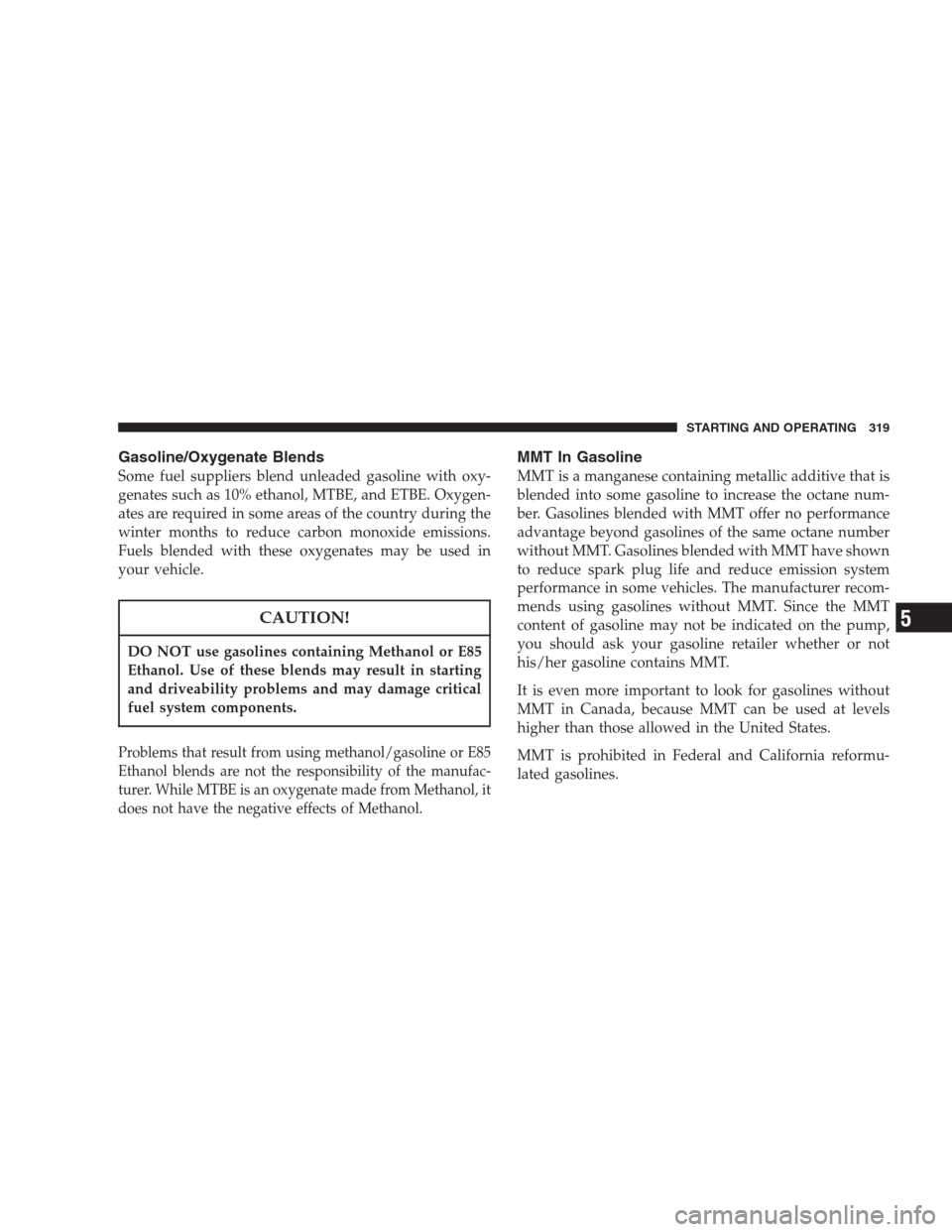
Gasoline/Oxygenate Blends
Some fuel suppliers blend unleaded gasoline with oxy-
genates such as 10% ethanol, MTBE, and ETBE. Oxygen-
ates are required in some areas of the country during the
winter months to reduce carbon monoxide emissions.
Fuels blended with these oxygenates may be used in
your vehicle.
CAUTION!
DO NOT use gasolines containing Methanol or E85
Ethanol. Use of these blends may result in starting
and driveability problems and may damage critical
fuel system components.
Problems that result from using methanol/gasoline or E85
Ethanol blends are not the responsibility of the manufac-
turer. While MTBE is an oxygenate made from Methanol, it
does not have the negative effects of Methanol.
MMT In Gasoline
MMT is a manganese containing metallic additive that is
blended into some gasoline to increase the octane num-
ber. Gasolines blended with MMT offer no performance
advantage beyond gasolines of the same octane number
without MMT. Gasolines blended with MMT have shown
to reduce spark plug life and reduce emission system
performance in some vehicles. The manufacturer recom-
mends using gasolines without MMT. Since the MMT
content of gasoline may not be indicated on the pump,
you should ask your gasoline retailer whether or not
his/her gasoline contains MMT.
It is even more important to look for gasolines without
MMT in Canada, because MMT can be used at levels
higher than those allowed in the United States.
MMT is prohibited in Federal and California reformu-
lated gasolines.
STARTING AND OPERATING 319
5
Page 320 of 464
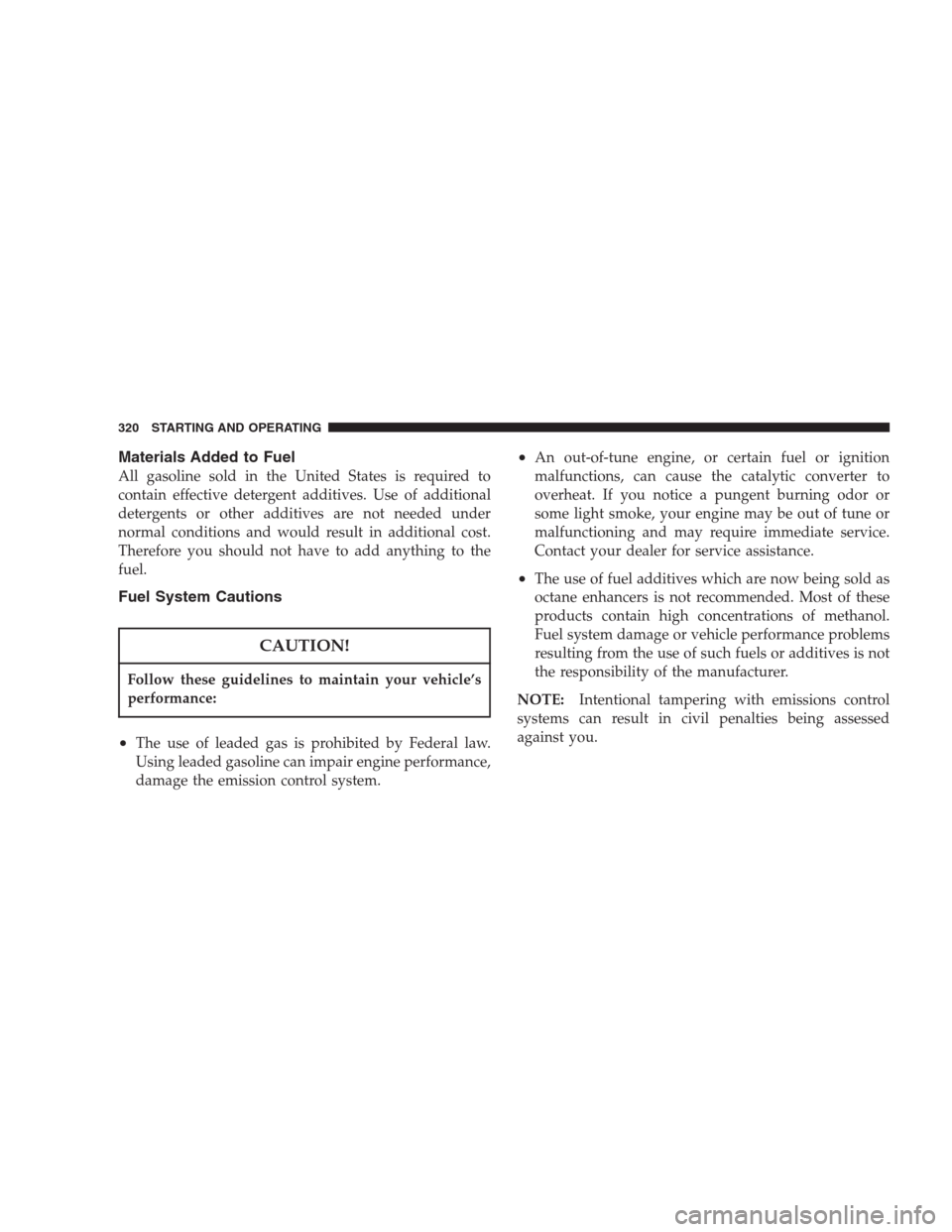
Materials Added to Fuel
All gasoline sold in the United States is required to
contain effective detergent additives. Use of additional
detergents or other additives are not needed under
normal conditions and would result in additional cost.
Therefore you should not have to add anything to the
fuel.
Fuel System Cautions
CAUTION!
Follow these guidelines to maintain your vehicle’s
performance:
•The use of leaded gas is prohibited by Federal law.
Using leaded gasoline can impair engine performance,
damage the emission control system.
•An out-of-tune engine, or certain fuel or ignition
malfunctions, can cause the catalytic converter to
overheat. If you notice a pungent burning odor or
some light smoke, your engine may be out of tune or
malfunctioning and may require immediate service.
Contact your dealer for service assistance.
•The use of fuel additives which are now being sold as
octane enhancers is not recommended. Most of these
products contain high concentrations of methanol.
Fuel system damage or vehicle performance problems
resulting from the use of such fuels or additives is not
the responsibility of the manufacturer.
NOTE:Intentional tampering with emissions control
systems can result in civil penalties being assessed
against you.
320 STARTING AND OPERATING